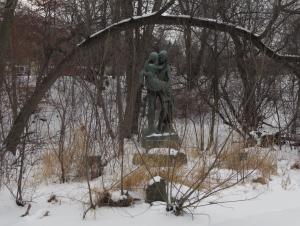| Romance Poetry posted January 26, 2016 | Chapters: |
...361 362 -363- 364... 
|
      |
Trochaic Tetrameter
A chapter in the book Little Poems
The Statue
by Treischel
|
This is a statue Hiawatha and Minnehaha, located at Minnehaha Falls in Minneapolis, Minnesota. It commemorates the "Song of Hiawatha" written by a local author and poet, William Wadsworth Longfellow, whose house is also preserved on the grounds. The statue was placed there in 1911. He wrote an epic poem about Hiawatha in 1855 that starts with those famous lines, "On the shores of Gitchee-Gumee, by the shining Big-Sea-Water". It was a long poem, written in Trochaic Tetrameter. There were 22 chapters to the book. Hiawatha was a heroic, larger-than-life legend among the Native Americans, much like Paul Bunyan. Longfellow captured some of them in his poem. The marriage to Minnehaha, bringing peace between the tribes in just one of them. I tried to capture that here in my own words, but mimicking the style used of Longfellow.
The poem is written in trochee, which is the opposite accent of iambic meter. Instead of a da DUM da DUM cadence, where the line ends with a strong accent. It has a tempo DA dum Da dum, where the line ends in a soft accent. It is contained in four poetic feet (8 syllables), or tetrameter. Therefore, trochaic tetrameter. Longfellow didn't use a rhyme scheme in his poem. It is characterized by Finnish language traits and story telling, that lend themselves well to Native American speech patterns too.
This photograph was taken by the author himself on January 23, 2016.
Pays
one point
and 2 member cents. The poem is written in trochee, which is the opposite accent of iambic meter. Instead of a da DUM da DUM cadence, where the line ends with a strong accent. It has a tempo DA dum Da dum, where the line ends in a soft accent. It is contained in four poetic feet (8 syllables), or tetrameter. Therefore, trochaic tetrameter. Longfellow didn't use a rhyme scheme in his poem. It is characterized by Finnish language traits and story telling, that lend themselves well to Native American speech patterns too.
This photograph was taken by the author himself on January 23, 2016.

You need to login or register to write reviews. It's quick! We only ask four questions to new members.
© Copyright 2024. Treischel All rights reserved.
Treischel has granted FanStory.com, its affiliates and its syndicates non-exclusive rights to display this work.


